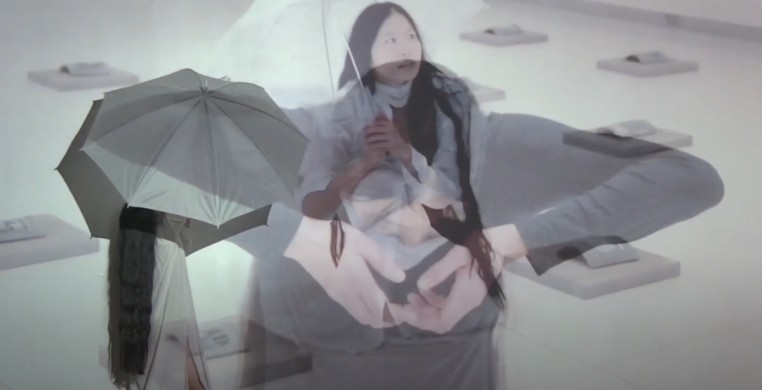If anyone is looking for an escape at home—and I assume we all are as we look towards another 30 days of a stay-at-home advisory—I highly recommend attending the Bridge Dance Festival’s latest showcase of captivating dance films. The festival, co-hosted by Asian Improv Arts Midwest and Links Hall and curated by Rika Lin, features works by four global dancemakers. In an hour-and-a-half, we are both literally and metaphorically transported around the world.
Artistis from Chicago and Japan are introduced by Lin in sequential order as their pieces are about to air. We meet Mari Fujihira first—who has bright purple hair and a rainbow glittery sweater—via Zoom from Tokyo. She giddily thanks the audience for supporting artists during this time as her work, “Sustainable,” underwent a substantial pivot since she hoped to be in Chicago to perform it.
Fujihira’s short film is an exploration of location. Dark lighting and an all-black, fringed costume give the footage a mysterious tone, but the setting— a bustling street in Tokyo— throws light and energy into the work. Her body moves in quick, spastic, uncontrolled bursts that mirror cagey pedestrians attempting to navigate their way around her. A smile across her face breathes joy into the otherwise hectic moment. As the footage cuts to a dimly lit back alley, there’s a breath of pause. The music, which was once driving and intense, softens to a gentle hum and her body’s extremities mimic the shift. She softens in both speed and intensity, clearly calmed by the significantly less-populated area. The remaining footage shifts back and forth from city to alley while the music steadily builds to a climax. Fujihira’s choreography is nonspecific but wholly captivating. “Sustainable” ends abruptly but it matches the unpredictable tone carried throughout the film.
“Transformation” by Irene Hsiao, a fellow Chicago Artist and a 2020 Chicago Dancemakers Forum Lab Artist, follows Fujihira’s piece. It’s a complete 180-degree shift in style. The “Allure of Matter” exhibit at the University of Chicago’s Smart Museum of Art, where Hsiao’s film is shot, is white and striking, brightening my computer screen. Hsiao performs in projected video against the museum wall and dances in front of herself with her hair down, which reaches almost to her mid-thigh. Haunting imagery paired with ominous, synth-heavy music brings a horror movie-esque vibe to the whole work. The entirely minimalistic aesthetic is enhanced by a muted grey, white and black color palette. As the film cuts in and out of focus, Hsiao plays with her projected shadow, though they never quite align. An umbrella brings the concept of shelter to mind, though for the 20-minute piece a meaning never fully develops. And it doesn’t feel necessary.
After a brief intermission we meet Ayako Kato, originally from Japan. Kato is a Chicago-based artist and an artist-in-residence at Hamlin Park Fieldhouse Theater under the Chicago Moving Company’s Dance Shelter program. She explains that her film, “Just Being,” should give audiences the experience of being all together despite being at home—a goal that is achieved by filming her movement entirely outdoors. Backed by a sound track by Mabel Kwan and Danny Clay, rain drop filled puddles enhance the grey scene as hands creep along a gravel covered ground. Imagery throughout “Just Being” doesn’t allows us to see Kato in her full figure until the very end. First person point of view footage and closeup filming of hands and feet allow the viewers to experience the work instead of watch it. The simplistic and soft movement is enhanced by artistic filming and, overall, the piece has a freeing, lighthearted tone that’s greatly welcome.
“Oni no Fu,” which translates to "Rhythm of Demons," closes out the evening. Performed by Mandarakoyomi Thinking—a 20-year-old improv unit from Kobe, Japan—founded by the duo of creators, dancer Masayuki Sumi and musician Shunichiro Hisada, tackled a beast of a piece. What was once a 70-minute piece is cut down to just shy of 30. The extraordinarily slow-moving work gives audience members a chance to lose themselves in their own thoughts, but the carefully edited film superimposes body over body in a way that brings focus back to the dance. The howling vocals sound forlorn to my American ears and the addition of piano and violin further enhance a melancholy tone. The pace of “Oni no Fu” makes it a curious note to end on, but the combination of pieces in this year’s Bridge Festival makes the night a must-see.
--
Bridge Dance Festival has one more performance Saturday, 7 p.m. via livestream from Links Hall. Tickets $15 or pay-what-you-can, available by clicking the event page below.


